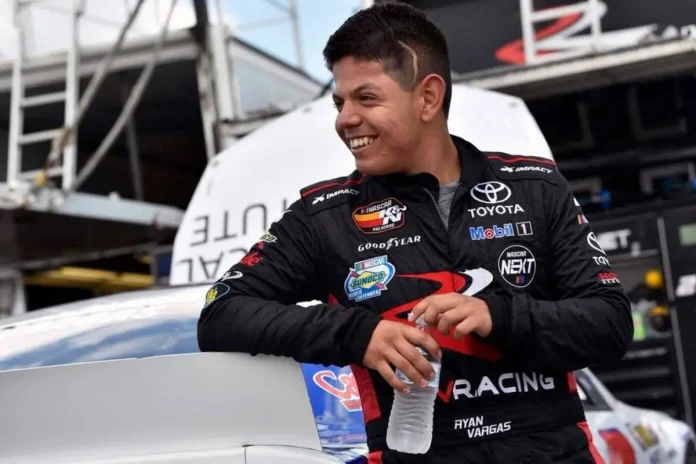Xfinity Star Urges NASCAR to Bring Back Dirt Races: Part-time Xfinity driver Ryan Vargas has rallied for the return of dirt races in NASCAR, following Bristol Motor Speedway‘s shift back to concrete in 2024. He advocates for the use of dedicated dirt tracks, which could resolve issues faced with modified pavement venues and improve racing excitement. Vargas believes that proper venue selection is vital for preserving race integrity and maximizing fan enjoyment.
Key Highlights
- Ryan Vargas advocates for dedicated dirt tracks, arguing they improve racing dynamics compared to modified pavement tracks.
- Vargas believes dedicated dirt venues enhance competitive aspects and spectator enjoyment, aligning with NASCAR’s strategic vision.
- He suggests that thoughtful venue selection is crucial for successful dirt racing integration into NASCAR events.
- Fans are divided, with some supporting dirt racing’s return and others questioning its feasibility within NASCAR’s core series.
- The debate continues on whether dirt racing should be limited to specific series like the Truck Series for better compatibility.
Bristol Motor Speedway Returns to Concrete
Although Bristol Motor Speedway‘s decision to revert to its concrete surface in 2024 may seem like a step backward for some racing purists, it highlights a vital moment in NASCAR’s evolving approach to balance tradition with innovation. Revered as ‘The Last Great Colosseum,’ Bristol has long been synonymous with intense, action-packed racing that captivates audiences.
The decision to return to concrete comes after an experimental phase of hosting dirt races, which, while novel, revealed important challenges for the Next-Gen cars in maintaining grip on the unconventional surface.
From an analytical perspective, this shift emphasizes NASCAR’s responsiveness to the sport’s technical demands and the preferences of its stakeholders. The Next-Gen cars, designed with aerodynamics and technology in mind, seem better suited to the high speeds and precision required on concrete tracks.
This move can be seen as an acknowledgment of the limitations posed by dirt racing, which, despite its nostalgic appeal, may not align with the current engineering ethos of the series.
Furthermore, the return to concrete is representative of NASCAR’s broader tactical goals. It seeks to preserve the essence of what makes its races compelling while adapting to the needs of modern engineering and fan expectations.
The change back to concrete does not necessarily signal a dismissal of dirt racing but rather a recalibration of priorities. This decision reflects a detailed understanding of the balance between honoring tradition and embracing technological advancement, ensuring the sport remains both competitive and entertaining for a diverse fanbase.

Evaluating NASCAR’s Dirt Track Experiment
NASCAR’s foray into dirt track racing at Bristol Motor Speedway sparked a range of reactions, emphasizing both the allure and the challenges of this bold experiment. While the notion of returning to the sport’s roots on dirt was initially met with enthusiasm, the execution revealed a complex duality.
Drivers like Josh Berry and Chris Buescher appreciated the nostalgia and novelty, yet others expressed concerns about whether the dirt surface truly delivered the high-stakes excitement that fans have come to associate with Bristol.
The dirt experiment was not without its memorable moments. Kyle Busch’s 2022 victory, capitalizing on a last-lap collision between Tyler Reddick and Chase Briscoe, highlighted the unpredictable nature of dirt racing. Such incidents illustrate the potential for high drama, yet they also raise questions about the consistency and competitiveness of the racing product.
Traditionalists argue that the inherent unpredictability of dirt racing can sometimes overshadow driver skill and strategy, elements that are central to NASCAR’s competitive ethos.
Despite these concerns, the allure of dirt racing lies in its ability to offer a distinct spectacle, setting it apart from the standard fare of asphalt and concrete tracks.
However, the question remains as to whether this novelty translates into a sustainable model for the future. The mixed reactions suggest that while dirt racing has its merits, it may not yet possess the consistent appeal necessary to become a fixture on the NASCAR calendar.
Ryan Vargas Advocates for Dirt Racing’s Return
Ryan Vargas has reignited the conversation surrounding the potential return of dirt racing in NASCAR, urging the sport to reconsider its approach. His call to action, prominently shared on social media, centers around the idea of utilizing tracks specifically designed for dirt racing rather than modifying existing pavement tracks like Bristol. Vargas’s perspective brings attention to the unique challenges and opportunities inherent in dirt racing, suggesting that NASCAR could gain from a more thoughtful strategy.
Vargas’s insights emphasize a crucial consideration: optimizing the racing experience by selecting appropriate venues. The adaptation of pavement tracks for dirt racing has been met with mixed reviews, highlighting difficulties in track maintenance and racing dynamics. Instead, investing in venues with dedicated dirt-racing infrastructure could improve both the competitive aspect and spectator enjoyment.
“random Sunday tangent. I sincerely hope NASCAR brings dirt racing back in some capacity. Not at Bristol, but maybe find a track that has *most* of the facilities needed and spruce it up a bit. It’s so fun watching guys search for grip in cars that simply aren’t made for this.” – Ryan Vargas
random Sunday tangent.
I sincerely hope NASCAR brings dirt racing back in some capacity. Not at Bristol, but maybe find a track that has *most* of the facilities needed and spruce it up a bit.
It’s so fun watching guys search for grip in cars that simply aren’t made for this. pic.twitter.com/l9PdMLcPCD
— Ryan Vargas (@RyanVargas_23) December 29, 2024
Vargas’s advocacy for dirt racing aligns with an evolving fanbase that appreciates the raw, unpredictable nature of such races. He suggests that finding a track with the necessary facilities could breathe new life into this racing format, offering an authentic experience that resonates with both drivers and fans. As NASCAR contemplates its future direction, embracing the insights from drivers like Vargas could prove crucial in crafting a more compelling, competitive season lineup.

Fans Divided Over Dirt Racing’s Future
Amidst the ongoing debate over the place of dirt racing in NASCAR, fans remain polarized on the issue, with opinions sharply divided on its potential return. Ryan Vargas‘ recent comments have only amplified this divide, sparking both support and criticism among the NASCAR community.
Some enthusiasts advocate for the return of dirt racing, suggesting that venues like Eldora Speedway—known for its dirt-specific design—would offer a more authentic and competitive experience. This sentiment is echoed by fans who believe that transforming existing pavement tracks into temporary dirt tracks fails to capture the essence of true dirt racing.
“If…IF it comes back, make it an actual dirt track like Eldora. Don’t just throw dirt onto a pavement track again.”
“was a neat concept…. let’s not bring it back.” – NASCAR fans reaction
Conversely, a segment of the fanbase expresses skepticism about the feasibility of integrating dirt races into NASCAR’s core series, particularly given the challenges faced by the Next-Gen cars regarding grip and handling on such surfaces. These fans propose restricting dirt racing to the Truck Series, where the vehicles might better accommodate the demands of a dirt track.
“truck series at charlotte dirt track please but please keep the cup cars away.”
“I’m probably one of the few that hated this. I found it boring, it was better watching tires blow out after 30 laps.” – NASCAR fans reaction
However, this suggestion is not without dissent, as a considerable number of fans outright dismiss the notion, describing past attempts as a novelty that holds limited appeal.
The polarity of opinions highlights a broader discourse within the NASCAR community about tradition versus innovation. Advocates for dirt racing often emphasize nostalgia and the sport’s roots, while opponents argue for a focus on the existing racing formats that have historically defined NASCAR’s brand.
The Future of Dirt Racing in NASCAR
Examining the future of dirt racing in NASCAR reveals a complex interplay between tradition and modernity. With the recent debate over its place on the calendar, NASCAR faces a significant decision. Some enthusiasts argue for its expansion, likening it to the rise of road courses. They assert that with tactical venue selection and meticulous preparation, dirt racing could rejuvenate the sport and capture new audiences. Yet, others argue that the spectacle of traditional concrete racing—particularly at iconic tracks like Bristol—offers unmatched excitement and should remain the priority.
Venue selection emerges as a vital determinant; alternate locations may better suit dirt racing, thereby improving its appeal. Event frequency remains contentious, with opinions divided on whether it should remain a novelty or evolve into a staple.
Fan engagement is another important aspect, as NASCAR must balance the interests of traditionalists with those enthusiastic for innovation. Ultimately, the decision will hinge on whether NASCAR can integrate dirt racing without overshadowing its storied past.
The allure of dirt racing lies in its ability to offer a fresh perspective. However, striking a balance between innovation and tradition is essential. As NASCAR deliberates its future, the challenge will be to craft a series that respects its history while embracing change, ensuring it remains relevant and exciting for generations to come.

News in Brief: Xfinity Star Urges NASCAR to Bring Back Dirt Races
The return of Bristol Motor Speedway to a concrete surface has reignited debate about the role of dirt racing in NASCAR. While the experiment with dirt tracks has been divisive, it has undeniably energized discussions about the sport’s future and heritage. Advocates, like Ryan Vargas, emphasize the value of diversity in race formats, highlighting potential growth in fan engagement and driver skills. As NASCAR evolves, the balance between tradition and innovation remains crucial in shaping its path.
ALSO READ: Ryan Vargas Tearfully Bids Farewell to Irwindale Speedway That Shaped His NASCAR Dreams


